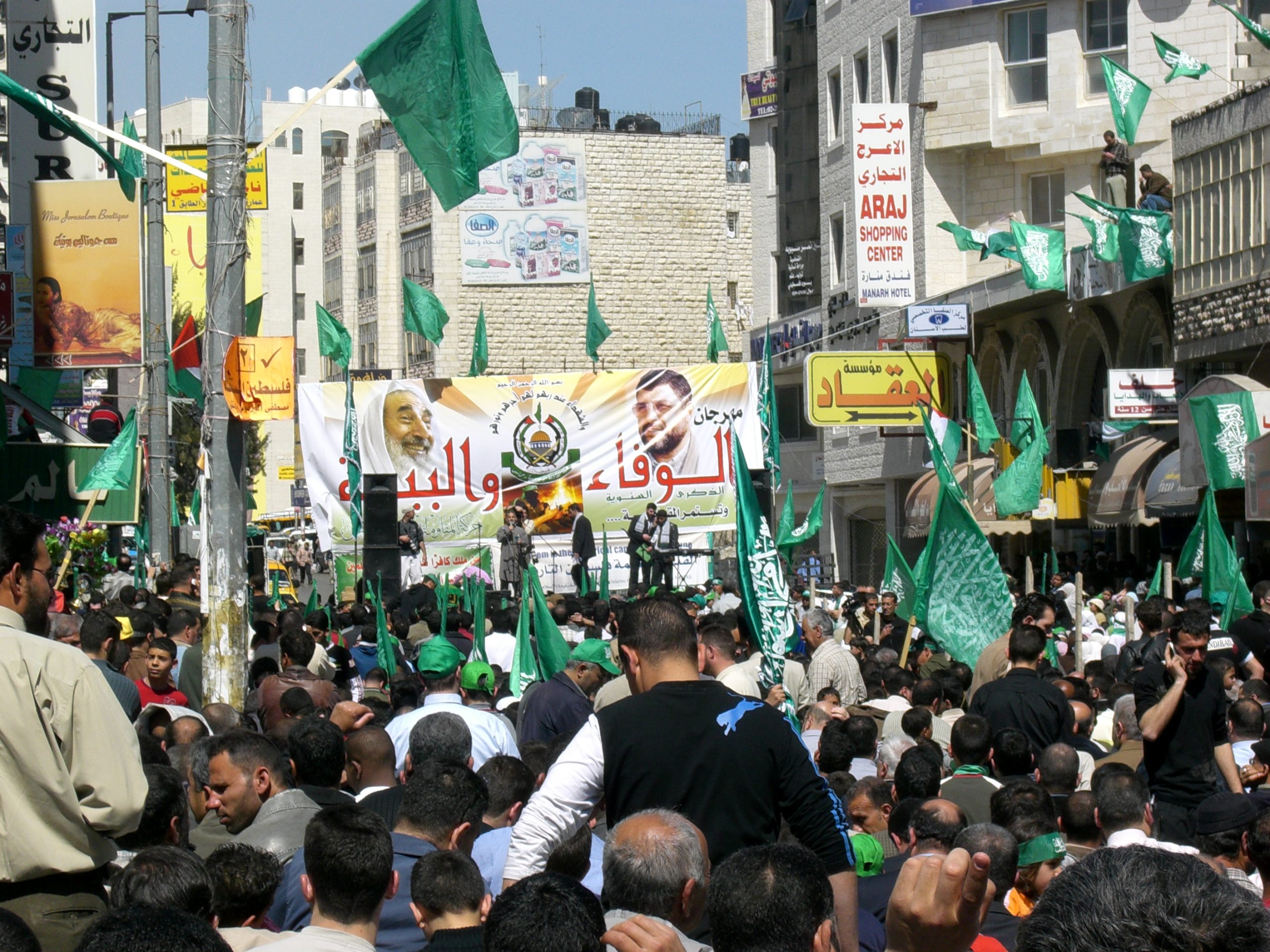More important than what has changed in the new charter of Hamas is why taking this step at the moment, and would it translate into anything on the ground?
BY MUHAMMAD SHEHADA
The dire situation that has stricken Hamas, and the repeated failure to secure a reliable survival strategy has fragmented its political structure between many conflicting opinions on three main challenges:
1- “Something must be done to secure financial support.”
2- “The Egyptian blockade must be broken.”
3- “Gaza must be spared a fourth war for as much time as we could.”
Two conflicting currents – who’s in control?
Yahia al-Sinwar’s current, which is now in the lead, is considered to be “the insider”. Their popularity and emergence to power are results of being seen as capable of bridging the gap with the most generous donor to the resistance, “Iran;” In the midst of Hamas’s terrible bankruptcy, Iran is deemed to be the only ally that can put Hamas back on track, and only Sinwar can please Iran.
Sinwar’s current is dismissive about reconciling with the West and deems these efforts as a “pathetic waste of time.” Instead, they believe that Hamas should keep alliance with Qatar and Turkey, move away from Abbas, reconstruct the “Hamas administration” in Gaza, move the armed resistance to the West Bank, and remove the Egyptian blockade by seducing the Egyptian president Sisi with prospective trade benefits with Gaza.
Quite the contrary is “the outsider” current led by Khalid Meshaal and Mousa Abu Marzook. They believe in a middle ground between diplomacy, politics and armed-resistance. They prioritize drawing new alliances and friendships, and believe that Hamas could be normalized and rebranded if sufficient efforts are exerted. They don’t go against getting funds from Iran, but simultaneously, they don’t pursue it. They are pro-creating alternatives, and they seem to believe in the importance of political representation, and in luring the PA president Abbas into reconciliation and elections in order to solve the problems of Gaza, give Hamas a moment to take a deep breath, and perhaps, if luck plays its part, take over the PLO, or at least offer Hamas to the West as a reasonable partner, worth engaging in the peace process, or in other words: “deserving a share of the cake.”
Although, both currents have respect for one another, they smile to each other’s faces and have good friendships. Sometimes they take each other’s advises, but when the opinions are in conflict, Sinwar’s fundamentalist leadership deem the outside leaders as “have lost their way and became too much open,” while the outside leadership deem Sinwar’s current as “politically inexperienced, and out of touch with reality.” And in the middle, always stand the chameleon, Ismael Hanyia, who always manages to magically please both sides, and appear as everybody’s friend.
For better or worse, Meshaal’s current doesn’t possess too much power on the actual ground in Gaza, and it’s rarely “listened to” when actions are taken. Its role is confined to an administrative and diplomatic one, besides securing funding.
The new charter, “too many cooks spoil the broth”
The very idea of producing a new charter has found its way within Hamas after decades of debate, punctuated by dozens of hardships and fears of eventual bankruptcy. Yet, the idea was deemed as “uncalled for” by the Sinwar’s current, who thought that moderating the charter will decrease the popularity of Hamas in the Middle East.
The charter was more or less, Khaled Meshaal’s farewell gift and legacy. For that purpose, the appointment of Hanyia as the new head of Hamas was delayed so that Meshaal could be the one to announce and discuss this project, before his retirement.
The most notable aspect of this project was a gesture of amenability and adaptability to the international community, explicitly expressed by Meshaal; that “Hamas could go through more changes if the circumstances move to the better or the worse, and the charter could be changed again.”
The first drafts of the charter were accurately written by a number of intellectuals and scholars, then it passed through a circle of editing and remarks-marking by literally every single Hamas leader, or friends of Hamas, and just as the saying “too many cooks spoil the broth,” the charter became one big mess, with evident contradictions.
However, in order to please everybody, lots of phrases seems to have been omitted, and others were forcibly added that didn’t fit in the context. The changes in the charter included one consensual aspect, which is distancing Hamas from the Muslim brotherhood in order to appease the Egyptian regime and remove the Egyptian blockade on Gaza. However, this seems to have provoked no response from the Egyptian government, or even Egyptian media, since their dispute with Hamas was not as much about their association to the Muslim Brotherhood as it was about appeasing the US, Israel, Dahalan and Abbas.
Accepting the 1967 borders, trying to “outsmart” the world
However, the most expected part of the charter was taking a clearer position on the conflict, and an updated vision to its final settlement. This change was represented firstly by dropping the explicit designation of Palestine as a “land of endowment;” In the old charter, Hamas deemed Palestine as a land of “waqf,” where it’s not up to the Palestinians to negotiate its fate, since it belongs to every single Muslim around the world. This meant that Hamas should not engage in a peace process that preserve the existence of Israel on Palestinian land, and instead it should work for the retrieval of Palestine from the river to the sea.
Perhaps the disappointing Arab position on Palestine, and Meshaal’s belief (and others) that Hamas could only survive by becoming a political player and a part of the equation was his reason to push for a change on this point. The final result was insisting that Palestine, from the river to the sea, belongs to the Palestinians, and at best Hamas is willing to accept the 1967 borders without recognizing Israel. This sounded similar to the stance of the Moroccan government on Ceuta and Melilla, the two Moroccan cities that are still occupied by Spain; every year, the government of Morocco calls on Spain to transfer the sovereignty of the two cities to their original owner, but nobody gives a darn, neither Spain, nor the UN. But for the people of Hamas, it was marketed as a “cunning and brilliant strategy” and “a step in the right directions” of liberating Palestine inch by inch, starting with the 1967 borders, then, when the circumstances are better, destroying Israel.
Added and removed parts, nobody gave a darn
The old charter’s “conspiracy theories” that accused the Jews of standing behind every crisis in the world, made no considerable difference when they were removed in the new charter, since most people aren’t even familiar with the old charter in the first place.
The other moderate changes remain nominal at best; this include the recognition of popular resistance, and the women’s part in the struggle and recognizing the equal rights of the Palestinian Christians. No wonder they didn’t get any attention, when it’s easier said than done.
For instance, Hamas’s acceptance of popular resistance in the new charter doesn’t by any chance mean allowing the civil society to recover and organize freely. It rather means that Hamas will do both armed and nonviolent resistance at the same time, by continuing to stage up controlled and directed protests that draw neither active participation nor international attention; because in order for popular resistance to succeed, it has to come from the people, and this seems too difficult for Hamas to understand.
Conclusion, you judge a tree by its fruits, not by what Meshaal says about it
The new charter is intended to ease the financial hardship of Hamas and end its isolation by a bunch of new slogans, yet, the Gazan leadership has never complied to Meshaal nor would it ever do in the future. The charter won’t have considerable changes on the ground. Nor would the West buy it with its current form, when stronger demonetization efforts are exerted. So, it won’t unexpectedly bring more money than Iran’s, and it won’t help Sinwar to believe in diplomacy, nor would it help Ismail Hanyia to stop being a chameleon.
In short, Meshaal made a gamble on moderation, but he gambled on the losing horse. With this charter, Meshaal inadvertently empowered the opposing current, since now they can safely say: “See! We tried Meshaal’s way, it didn’t work.”





